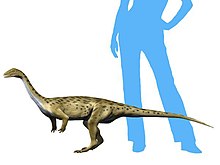Saturnaliidae: Difference between revisions
temporal range extended to 230mya to accommodate for chromogisaurus |
|||
| Line 22: | Line 22: | ||
==Classification== |
==Classification== |
||
In 2010, [[Martin Ezcurra]] defined the subfamily Saturnaliinae for the clade containing ''[[Saturnalia (dinosaur)|Saturnalia]]'' and ''[[Chromogisaurus]]'', which were found to be close relatives in several studies.<ref name=Ezcurra2010></ref> While they are sometimes found to be a subgroup within the [[Guaibasauridae]],<ref name="Ezcurra2010">{{cite journal|author8=Ezcurra, M. D.|year=2010 |title=A new early dinosaur (Saurischia: Sauropodomorpha) from the Late Triassic of Argentina: a reassessment of dinosaur origin and phylogeny|journal=Journal of Systematic Palaeontology|volume=8 |issue=3 |pages=371–425 |doi=10.1080/14772019.2010.484650|last1=Ezcurra|first1=Martin D.}}</ref> other studies have found the saturnaliines to form an independent lineage at the very base of the sauropodomorph family tree.<ref name=Leyesaurus>{{cite journal |year=2011 |title=A New Basal Sauropodomorph (Dinosauria: Saurischia) from Quebrada del Barro Formation (Marayes-El Carrizal Basin), Northwestern Argentina |journal=PLoS ONE |volume=6 |issue=11 |pages=e26964 |doi=10.1371/journal.pone.0026964 |author=Cecilia Apaldetti |author2=Ricardo N. Martinez |author3=Oscar A. Alcober |author4=Diego Pol |last-author-amp=yes |editor1-last=Claessens |editor1-first=Leon |pmid=22096511 |pmc=3212523 }}</ref> Langer and colleagues (2019) recovered ''[[Pampadromaeus]]'' and ''[[Panphagia]]'' as relatives of ''Saturnalia'' and ''Chromogisaurus'', elevating Saturnaliinae to family rank as '''Saturnaliidae'''. They recovered ''Guaibasaurus'' as a basal theropod.<ref>Langer MC, McPhee BW, Marsola JCdA, Roberto-da-Silva L, Cabreira SF (2019) Anatomy of the dinosaur ''[[Pampadromaeus barberenai]]'' (Saurischia—Sauropodomorpha) from the Late Triassic Santa Maria Formation of southern Brazil. PLoS ONE 14(2): e0212543. https://doi.org/10.1371/journal.pone.0212543</ref> |
In 2010, [[Martin Ezcurra]] defined the subfamily Saturnaliinae for the clade containing ''[[Saturnalia (dinosaur)|Saturnalia]]'' and ''[[Chromogisaurus]]'', which were found to be close relatives in several studies.<ref name=Ezcurra2010></ref> While they are sometimes found to be a subgroup within the [[Guaibasauridae]],<ref name="Ezcurra2010">{{cite journal|author8=Ezcurra, M. D.|year=2010 |title=A new early dinosaur (Saurischia: Sauropodomorpha) from the Late Triassic of Argentina: a reassessment of dinosaur origin and phylogeny|journal=Journal of Systematic Palaeontology|volume=8 |issue=3 |pages=371–425 |doi=10.1080/14772019.2010.484650|last1=Ezcurra|first1=Martin D.}}</ref> other studies have found the saturnaliines to form an independent lineage at the very base of the sauropodomorph family tree.<ref name=Leyesaurus>{{cite journal |year=2011 |title=A New Basal Sauropodomorph (Dinosauria: Saurischia) from Quebrada del Barro Formation (Marayes-El Carrizal Basin), Northwestern Argentina |journal=PLoS ONE |volume=6 |issue=11 |pages=e26964 |doi=10.1371/journal.pone.0026964 |author=Cecilia Apaldetti |author2=Ricardo N. Martinez |author3=Oscar A. Alcober |author4=Diego Pol |last-author-amp=yes |editor1-last=Claessens |editor1-first=Leon |pmid=22096511 |pmc=3212523 }}</ref> At one point, ''[[Agnosphitys]]'' was recovered as a possible saturnaliine until it was reclassified into the [[Silesauridae]] in 2017.<ref>Baron, M.G., Norman, D.B., and Barrett, P.M. (2017). A new hypothesis of dinosaur relationships and early dinosaur evolution. ''Nature'', '''543''': 501–506. {{doi|10.1038/nature21700}}</ref> Langer and colleagues (2019) recovered ''[[Pampadromaeus]]'' and ''[[Panphagia]]'' as relatives of ''Saturnalia'' and ''Chromogisaurus'', elevating Saturnaliinae to family rank as '''Saturnaliidae'''. They recovered ''Guaibasaurus'' as a basal theropod.<ref>Langer MC, McPhee BW, Marsola JCdA, Roberto-da-Silva L, Cabreira SF (2019) Anatomy of the dinosaur ''[[Pampadromaeus barberenai]]'' (Saurischia—Sauropodomorpha) from the Late Triassic Santa Maria Formation of southern Brazil. PLoS ONE 14(2): e0212543. https://doi.org/10.1371/journal.pone.0212543</ref> |
||
==References== |
==References== |
||
Revision as of 22:36, 4 August 2020
| Saturnaliinae Temporal range: Late Triassic,
| |
|---|---|

| |
| Life restoration of Saturnalia tupiniquim | |
| Scientific classification | |
| Missing taxonomy template (fix): | Saturnaliinae |
| Type species | |
| †Saturnalia tupiniquim Langer et al., 1999
| |
| Genera and subgroups | |
| Synonyms | |
| |
Saturnaliinae is a clade (or subfamily) of sauropodomorph dinosaurs belonging to the Guaibasauridae found in Brazil and Argentina.[1]
Classification
In 2010, Martin Ezcurra defined the subfamily Saturnaliinae for the clade containing Saturnalia and Chromogisaurus, which were found to be close relatives in several studies.[1] While they are sometimes found to be a subgroup within the Guaibasauridae,[1] other studies have found the saturnaliines to form an independent lineage at the very base of the sauropodomorph family tree.[2] At one point, Agnosphitys was recovered as a possible saturnaliine until it was reclassified into the Silesauridae in 2017.[3] Langer and colleagues (2019) recovered Pampadromaeus and Panphagia as relatives of Saturnalia and Chromogisaurus, elevating Saturnaliinae to family rank as Saturnaliidae. They recovered Guaibasaurus as a basal theropod.[4]
References
- ^ a b c Ezcurra, Martin D. (2010). "A new early dinosaur (Saurischia: Sauropodomorpha) from the Late Triassic of Argentina: a reassessment of dinosaur origin and phylogeny". Journal of Systematic Palaeontology. 8 (3): 371–425. doi:10.1080/14772019.2010.484650.
- ^ Cecilia Apaldetti; Ricardo N. Martinez; Oscar A. Alcober; Diego Pol (2011). Claessens, Leon (ed.). "A New Basal Sauropodomorph (Dinosauria: Saurischia) from Quebrada del Barro Formation (Marayes-El Carrizal Basin), Northwestern Argentina". PLoS ONE. 6 (11): e26964. doi:10.1371/journal.pone.0026964. PMC 3212523. PMID 22096511.
{{cite journal}}: Unknown parameter|last-author-amp=ignored (|name-list-style=suggested) (help)CS1 maint: unflagged free DOI (link) - ^ Baron, M.G., Norman, D.B., and Barrett, P.M. (2017). A new hypothesis of dinosaur relationships and early dinosaur evolution. Nature, 543: 501–506. doi:10.1038/nature21700
- ^ Langer MC, McPhee BW, Marsola JCdA, Roberto-da-Silva L, Cabreira SF (2019) Anatomy of the dinosaur Pampadromaeus barberenai (Saurischia—Sauropodomorpha) from the Late Triassic Santa Maria Formation of southern Brazil. PLoS ONE 14(2): e0212543. https://doi.org/10.1371/journal.pone.0212543












